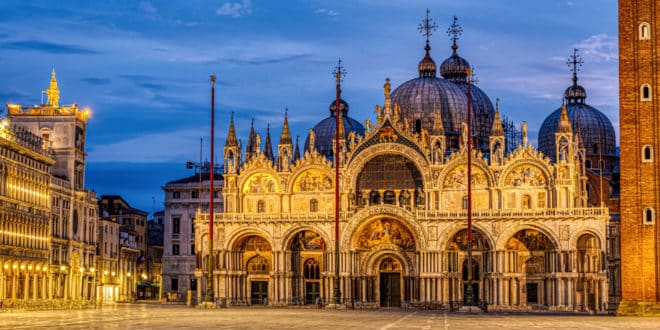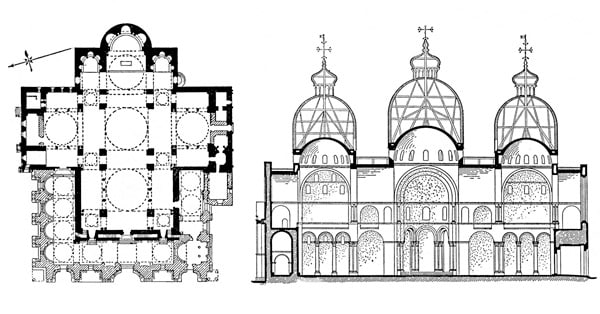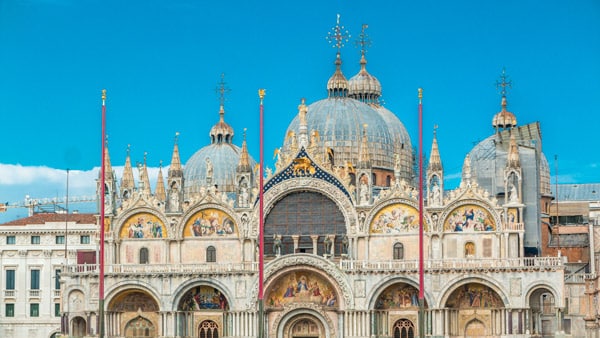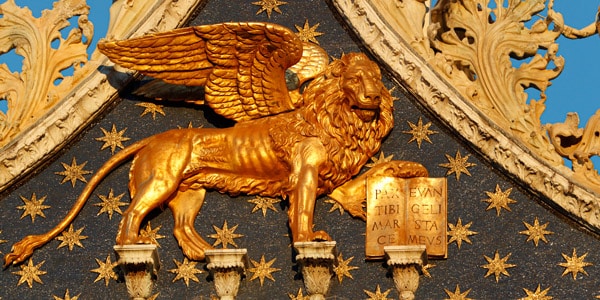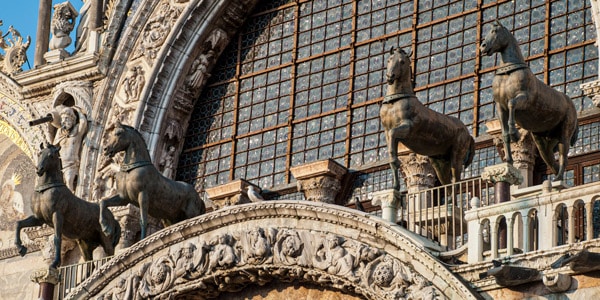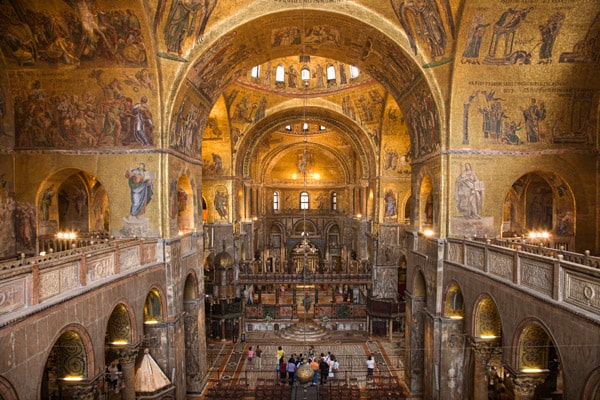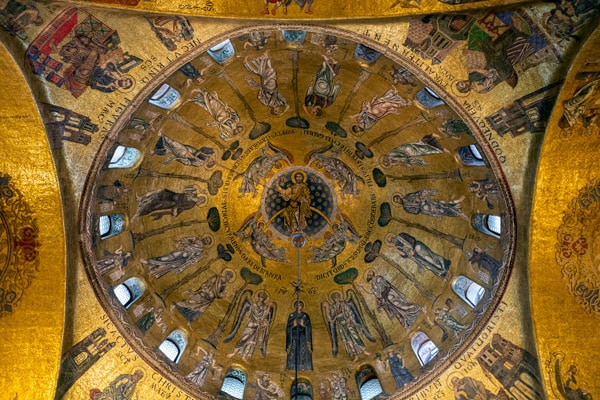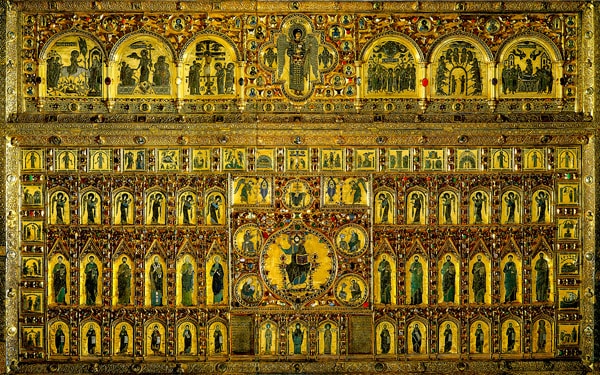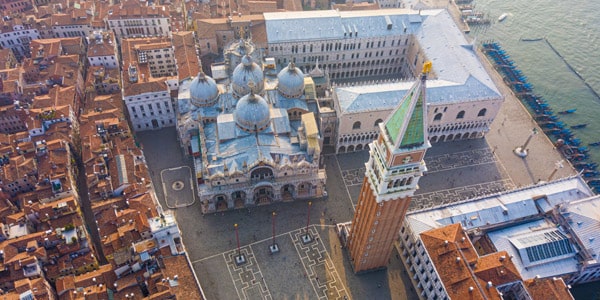St. Mark’s Basilica (Basilica di San Marco) is the cathedral church of the Roman Catholic Patriarchate of Venice (Patriarcato di Venezia), holding the status of a minor basilica. This main church of the city is listed among Italy’s National Monuments and is a UNESCO World Heritage protected site.
St. Mark’s Basilica is globally renowned as a unique architectural masterpiece, and together with the adjacent St. Mark’s Square (Piazza di San Marco) and the Campanile (Campanile di San Marco) symbolize Venice.
Built in the image of one of the churches of Constantinople, the Italian basilica became a showcase of Byzantine trophies – priceless witnesses of ancient Christian culture.
Page Contents
Opening Hours in 2024 and Tickets
St. Mark’s Basilica is open from Monday to Saturday from 9:30 to 17:00. From April 16 to October 28, on Sundays and holidays, the cathedral is open until 16:30. The opening hours are extended to 17:00 from October 29 to April 15.
In all cases, the last entry time is 15 minutes before closing.
Opening hours may vary on religious holidays, especially during Easter and Christmas.
To skip the queue, I recommend purchasing tickets online in advance. A full ticket costs 25 euros and guarantees quick entry to St. Mark’s Basilica, the museum, Pala D’Oro, the observation deck, and a downloadable audio guide app for your phone.
Saint Mark
The cathedral of Venice is named after Saint Mark – a disciple of the apostles Peter and Paul, the first bishop of Alexandria (founder of Christianity in Africa), and the author of the second of the four Gospels of the New Testament.
The basilica’s history is connected with the Lion of Saint Mark – the iconic symbol of the evangelist. According to legend, an angel in the form of a winged lion appeared to the saint, who suffered a shipwreck in the waters of the Venetian lagoon and said: “Peace be with you, Mark, my evangelist. Here your body will find rest.”
Guided by these prophetic words, two Venetian merchants, Buono da Malamocco and Rustico da Torcello, in 828 AD, stole the saint’s body from Alexandria and brought it to their native city for eternal repose.
The story of the “rescue” of the relics is quite fascinating. Rumors that Caliph Al-Mamun had ordered the destruction of the Christian church in Alexandria with the remains of Saint Mark to build a new mosque prompted the Venetians to a daring theft. They secretly entered the Egyptian temple at night and removed the body of the evangelist, replacing it with the relics of Saint Claudia. To transport the valuable cargo to the ship, they hid it in a basket with pig carcasses and vegetables. Muslim customs officers did not suspect anything and did not inspect it, as their religion forbade touching the meat of “unclean” animals.
Read more about the history of the Republic of Venice.
Construction
On January 31, 828 AD, a crowd of townspeople in the port of Venice joyfully greeted the relics of Saint Mark and chose him as the new patron of the city, replacing the Byzantine Saint Theodore. The evangelist’s remains were not transferred to the old church but temporarily placed in the guarded castrum of the Doge’s Palace (Palazzo Ducale). The Venetians decided to erect a separate church for their main saint.
First Church, c. 829–976 AD
The construction of the first church dedicated to Saint Mark began in 829 AD by Doge Giustiniano Participazio and was completed in 832 AD by his brother, Doge Giovanni Participazio.
Excavations have confirmed that the ancient structure was located where the current crypt of the cathedral is and was most likely similar to the early Christian Basilica of San Vitale in Ravenna (Ravenna). The remaining foundation gives some idea of the structure of the first church. The central dome above the burial place of the relics and the building’s plan in the form of a Greek cross classify it as a Martyrium – a particular type of Christian cult building, the architecture of which was borrowed from Roman mausoleums of the imperial era.
The Second Church, 976 – c. 1063 AD
The fire of 976 AD, instigated by rebels in the Doge’s Palace, destroyed the nearby St. Mark’s Church and about 200 houses in Venice. The new Doge, Pietro I Orseolo, elected in place of the overthrown Doge Pietro IV Candiano by a popular uprising, repaired the church with his own money within two years.
The appearance of the second church has not been precisely determined, but it likely didn’t differ significantly from the first, considering the short timeframe of the reconstruction. At this time, a brick vault was built over Saint Mark’s tomb, located in the apse, which more securely protected the relics. This semi-enclosed sanctuary would later be included in the crypt of the third church.
The Third Church, 1063 AD
In 1063 AD, under Doge Domenico I Contarini, construction began on the present St. Mark’s Basilica. It was erected over the old church, the remnants of which were used to construct the crypt.
The new basilica was significantly larger and different in form from its predecessor: it featured brick domes, robust cylindrical vaults, arcades, a narthex in front of the western façade, and a new altar.
The church’s consecration took place on October 8, 1094 AD. The saint’s relics were placed in the new crypt on the same day. This event is shrouded in legend.
According to some sources, at that time, the location of the evangelist’s remains had been lost, so securely had they been hidden for fear of theft. They were found miraculously. At the end of the solemn Mass, one of the columns on the right aisle split open, revealing a box with the fragrant relics of the saint.
I recommend reading: Who were the Venetian Doges?
Subsequent Interventions
Subsequent reconstructions did not significantly alter the structure of the third St. Mark’s Basilica but changed its exterior and made it one of the most original and recognizable churches in the world.
Notable changes affected the finishing and interior decoration, which endowed the Venetian cathedral with features of Romanesque and Gothic styles and Eastern Islamic architecture.
The basilica’s appearance was significantly enriched in the 13th century by taller domes, expensive marble cladding, and decorative elements such as columns, reliefs, and sculptures. Some of these were taken from palaces and churches in Venice, while others were brought from Constantinople, which the Venetians had participated in plundering during the Fourth Crusade in 1204.
The new church of Venice differed sharply in structure and style from the more familiar rectangular basilicas of Italy and referenced the Byzantine tradition of church construction. Thus, the private church of the Doge’s Palace (which remained so until 1807) became a symbol of the close political and economic ties between Venice and Byzantium.
Structure
The Church of the Holy Apostles in Constantinople was the architectural model for St. Mark’s Basilica — the second largest and most important church after the famous Hagia Sophia. The appearance of the Byzantine church can only be inferred from descriptions and surviving images, as it was destroyed by the Turks in 1461.
The structure of St. Mark’s Basilica is divided into three levels:
- The main lower floor;
- The upper passageway terrace;
- The domes.
The wide base (75.5 x 62.7 m) and relatively modest height (43 m) are explained by the common building practice in Venice – to provide stability to the structure built on sandy soil.
The complex architectural composition combines the plans of a concentric Greek cross of the Byzantine type and a slightly elongated axis typical of Italian basilicas.
The church has three naves along the long axis of the cross, which are divided by four robust bases and columns, and three shorter naves of the transept.
The five domes rest on four cylindrical vaults, with the central and western domes being more extensive than the others, as they mark the direction to the east towards the altar – the main nave for religious ceremonies.
Surrounding the central dome of the basilica are three two-story galleries, of which the western and northern form the narthex (an annex in front of the church entrance), and the southern is the baptistery.
The basilica plan also includes the Treasury, the Chapel of St. Isidore of Chios, and the Chapel of Cardinal Giovanni Battista Zeno, known as the Zen Chapel.
Facades
The three facades of St. Mark’s Basilica, which initially adhered to the strict Romanesque style, acquired their current luxurious appearance in the 13th to 15th centuries.
The northern facade, with its aedicules and lunettes adorned with statues of Church Teachers and allegorical figures, is less diverse and richly decorated compared to the other two facades.
Western Facade
Of the three facades, the main one is the western, with its five majestic portals framed by tiers of Byzantine columns.
The arches of the entrances and the lunettes above them with a Gothic crown are decorated with mosaics made in the 17th and 18th centuries, maintaining medieval iconography and style. The central portal’s door, adorned with bronze plates, dates back to the 6th century. It was brought from Constantinople and served as a model for the others, created by local craftsmen in the 12th–14th centuries.
The central arch of the terrace is crowned with a statue of Saint Mark, and just below is a winged lion holding a book with the angels’ greeting: “Peace be with you, Mark, my evangelist.”
In the upper row of the terrace, in the aedicules, are figures of the evangelists, and at the edges are statues of the Virgin Mary and Archangel Michael, as a reminder of the founding date of Venice – March 24, 421, on the feast of the Annunciation.
Southern Facade
The southern facade, facing the Doge’s Palace and the sea, impresses with its rich decor. It features rare marble columns, statues of saints like Anthony the Abbot and Paul the Hermit, and allegorical figures of Fortitude and Justice.
Among the sculptures on the southern facade, the composition of red porphyry “The Four Tetrarchs” (Monumento ai Tetrarchi) is particularly noteworthy.
Previously, it adorned a building in the Philadelphion, an essential square in Constantinople. This group of pairs of embracing men dates back to the first half of the 4th century and represents the co-emperors of the Tetrarchy period (a system of joint rule of the Roman Empire) or the three sons and nephews of Constantine the Great.
Quadriga of Saint Mark
The most unique decoration of the basilica’s western facade is the gilded copper Horses of Saint Mark (Cavalli di San Marco), installed on the terrace above the main entrance in 1254.
The Horses of San Marco were among the first trophies brought back from Constantinople in 1204 and became a symbol of the Serenissima’s triumphant victory over Byzantium.
This sculptural composition is unique in its artistic value and the only surviving quadriga from the times of classical antiquity. Its authorship remains disputed, attributed to either the Greek sculptor Lysippus (4th century BC) or Roman artisans of the 2nd-3rd century AD.
It is well known that the gilded horses adorned the hippodrome in Constantinople for a long time before they were stolen by the Venetians.
The Quadriga of Saint Mark has not always been on the facade of the basilica. Napoleon couldn’t resist the temptation and, in 1797, took it to Paris, where he used it to decorate his Carrousel Triumphal Arch. In 1815, the horses were returned to the terrace of the Venetian basilica, and since then, they have been removed several times to protect them from damage during wars.
After the restoration in 1970, it was decided to place the original Quadriga of San Marco in the basilica’s museum, and its replica was installed on the terrace, where it has been since 1984.
Read about the most beautiful palaces in Venice.
Mosaics
The interior of St. Mark’s Basilica is primarily striking for its abundance and splendor of mosaics, which are everywhere – on the vaults of all the domes, arches, lunettes, niches, the upper part of the walls, and the floor. They cover about 4,000 square meters and represent one of the largest mosaic complexes in the world.
The first images made of enamel pieces (a particular type of colored glass) were created in the apse between 1071 and 1084, while most of them were created in the 13th century. In the 16th-18th centuries, more “modern” mosaics appeared in the basilica, restored based on the sketches of such famous artists as Titian (Tiziano Vecellio), Tintoretto, Paolo Veronese, Giuseppe Salviati, Giovanni Battista Piazzetta, and Sebastiano Ricci.
The golden background of the mosaic images brought the Venetian church the fame of the “Golden Basilica.” The secret of the mosaics’ soft internal glow lies in a special laying technique, where a layer of enamel, produced using a special technology on the island of Murano, was applied on a substrate of gold foil.
I recommend reading about Murano Glass.
The mosaic themes of the basilica cover almost all pages of Christian history and present them sequentially and very engagingly.
In the narthex of the basilica, six small domes are covered with 13th-century mosaics. They depict stories from the Old Testament and episodes from the lives of Noah, Abraham, Joseph, and Moses. The Dome of the Creation of the World is of particular value and interest, which shows 26 scenes, including some very rare for churches – the creation of Eve from Adam’s rib, the temptation by the serpent, the expulsion from paradise, and the blessing of the seventh day.
Towards the altar, the golden mosaics of the western Pentecost Dome and the central Ascension Dome, made in the 12th century in a traditionally Byzantine style, unfold.
Above the main altar rises the star-studded Dome of Emmanuel, depicting a young Jesus and figures of the Virgin Mary and Old Testament prophets.
The baptistery and chapels of the basilica are also richly decorated with mosaics.
Pala d’Oro
The main altar of St. Mark’s Basilica is adorned with one of the most exquisite treasures of Byzantine culture, known as the Pala d’Oro (Golden Altar).
This grandiose panel measuring 212×334 cm is made of gold, silver, enamels (187 plates), and precious stones (about 2,000 pieces). The Golden Altar was commissioned in Constantinople by Doge Ordelaffo Falier specifically for St. Mark’s Church in 1102 and was enriched with new decorations until the 14th century.
The enamels of the Pala d’Oro are particularly valuable. The top row contains the image of Archangel Michael and episodes from the life of Christ. The lower panels of the first horizontal and side order narrate stories about Saint Mark. At the center is the altar image of Christ, surrounded by the four evangelists writing their books.
The Golden Altar has been permanently open only since the mid-20th century; before that, it was accessible for viewing only on religious holidays.
Crypt
The crypt is the oldest part of the basilica, preserving remnants of the 9th-century church. It is located under the presbytery and the side chapels of the apostle Peter and Saint Clement. In the center is a chapel adorned with an ornate marble plate of Byzantine craftsmanship. Until 1835, it housed the relics of Saint Mark, before they were moved to the main altar.
Baptistery
The baptistery, consisting of three rooms, is located in the southern gallery of the basilica and dates back to the 14th century. It was built at the behest of Andrea Dandolo (Andrea Dandolo), the Doge of Venice (1343-1354), a well-known humanist and friend of Francesco Petrarch (Francesco Petrarca).
The interior’s main feature is the baptismal font with a bronze lid, adorned with reliefs by Jacopo Sansovino. The mosaic themes are mainly dedicated to John the Baptist and baptism scenes. When exiting the baptistery, consider the exciting depiction in the lunette “The Dance of Salome and the Martyrdom of John the Baptist.”
The baptistery became the burial place for two doges – Giovanni Soranzo and Andrea Dandolo, the latter being the last ruler of Venice to be buried in St. Mark’s Basilica.
Museum
The San Marco Museum, founded in the 19th century, was reopened in 2003. It is located on the second floor of the western and northern part of the narthex, accessible by a staircase right at the entrance through the main portal. The museum’s exhibition, dedicated to the history of St. Mark’s Cathedral, occupies an area of 1,000 square meters.
The collection includes a variety of items – fragments of mosaics, samples of marble, terracotta, and bronze statuettes, paintings and drawings, tapestries, antique fabrics, and much more. The pride of the collection is the Horses of Saint Mark, which, since 1984, can be admired up close and in detail.
Treasury
A small collection of valuable items from St. Mark’s Basilica is housed in a separate Treasury (Tesoro di San Marco) in the southern part of the building. It consists of 283 items, most of which are military spoils from Constantinople brought by Doge Enrico Dandolo in 1204: religious relics, liturgical items, icons, manuscripts, jewelry, and metal, and stone artifacts.
A significant part of the Treasury’s items was destroyed in the fire of 1231 and in the 18th century, when Napoleon ordered the melting of 535 kg of gold and silver artifacts to replenish his Treasury. Among the most precious sacred relics, fragments of the True Cross and a vial of the Holy Blood of Christ have survived.
Campanile
The Campanile of San Marco, standing next to the cathedral, rises 98.6 meters above the ground and is one of the tallest in Italy. Venetians affectionately call it “The Master of the House” (El paron de casa).
I recommend reading about the tallest towers in Italy.
The first structure at this site, built in the 9th century, served as a watchtower and lighthouse. From the 12th to the 16th century, a series of reconstructions altered the appearance of the bell tower to its current form. Frequent earthquakes, lightning, floods, and fires never destroyed this Venice landmark, as the Campanile of San Marco was always reborn.
The last terrible collapse occurred in 1902 after an attempt to modify the tower’s structure to build an elevator. The culprits were not executed, as was the custom in medieval times, and fortunately, there were no accidental human casualties (except for the death of the bell tower keeper’s cat). The Venice city authorities decided to build a new tower, adhering to the already famous principle “where it was and as it was” (dov’era e com’era). The rebuilt Campanile of San Marco, with a reinforced structure, was solemnly opened on April 25, 1912, during the patron saint’s festival.
Tickets and Opening Hours of the Bell Tower
The Bell Tower is open daily from 9:30 AM to 9:15 PM (last entry: 8:45 PM; ticket: 10 euros; free for children under 6 years). In case of adverse weather conditions (fog, strong wind, severe frost), the bell tower is closed to visitors.
It’s important to consider that the waiting time in the queue for the ticket office can range from 1 to 3 hours. To save time, I recommend reserving tickets online in advance.
The image of the beautiful Venice would be incomplete without St. Mark’s Basilica – an amazing Italian church with a magnificent heritage of Byzantine culture.
Only a great trading and naval power like the Serene Republic of Venice could create a tangible monument to its might, authority, and wealth over several centuries.
The official website of St. Mark’s Basilica www.basilicasanmarco.it
 Italy for me From Italy with love
Italy for me From Italy with love

